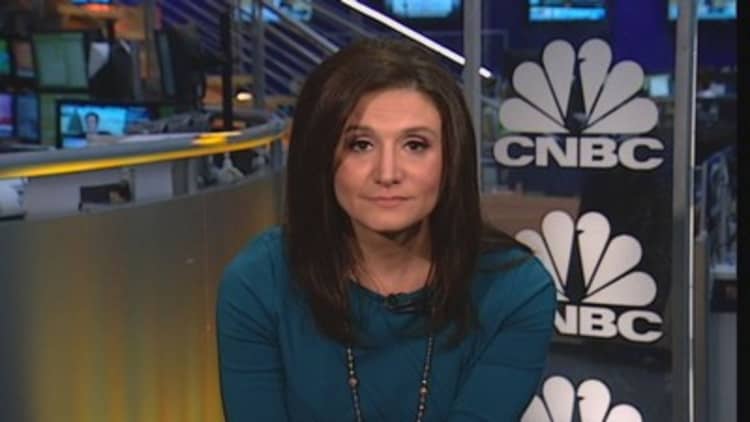China's central bank appears to have underlined its commitment to currency reform by allowing the yuan to set record highs against the dollar despite signs of unexpected weakness in exports.
The hit a second consecutive record intraday high of 6.1011 on Tuesday, after the People's Bank of China set its mid-point - the center of the currency's 2 percent daily trading band - at an all-time peak the previous day.
The currency moves came hot on the heels of official data showing Chinese exports slid in September by 0.3 percent from a year earlier.
(Read more: Is inflation a new risk for China's economy?)
The export figures confounded expectations for a 6 percent rise and marked the worst performance in three months.
A stronger yuan is a key goal for policymakers trying to wean the economy off a heavy emphasis on exports more towards consumption-led growth.

But they face complaints from Chinese exporters that the yuan's enduring strength is putting their products at a disadvantage in overseas markets even as foreign demand remains tepid.
The yuan is up around 2 percent in 2013, in marked contrast to slides posted by other Asian currencies, and more than 35 percent higher since a revaluation in 2005.
"Domestic businesses hope there won't be more rises for the yuan, because exports are still really weak. If the yuan keeps rising, the results could be really ugly," said a currency trader at a European bank in Shanghai.
In addition, the unexpected weakness in September's exports raised fresh concerns that economic growth - which has fallen in nine of the last 10 quarters - could stumble once again just as it has shown signs of picking up.
A similar surprise dip in exports occurred in June and analysts said at the time that the yuan's strength was partly to blame.
(Read more: Yuan moves one step closer to global currency status)
Some economists predicted the central bank would be forced to let the yuan slip back, at least symbolically. Instead, it held a firm line.
The currency has also risen in trade-weighted terms every month since Sept 2012 until finally declining slightly in August, data from the Bank for International Settlements (BIS) shows. BIS data for September should be released later this week.
Are the bulls back?
The spot yuan market has been tightly range-bound since mid-August. The exchange rate has been mostly steady with minimal intraday volatility, so the recent breakout has startled market participants.
"I must say I find it really strange," said a forex dealers at a joint-stock bank in Shanghai. "Fundamentally there's no major factor to push up the yuan. Maybe Big Brother (the PBOC) has stopped interfering, and so the dollar is sliding. We'll have to wait for the afternoon to see if this is sustained."
Traders attributed the market's previous torpor to regular dollar-buying by major state-owned banks, which effectively held back the yuan from appreciating, and many speculated that this was conducted on secret behest of the central bank in order to hold the spot rate flat even while it raised the midpoint.
Some suggested the government was setting the stage for another widening of the official daily trading band - currently 1 percent either side of the midpoint - to allow more two-way movement in the rate, increasing risk and by extension discouraging further aggressive speculation in the currency by Chinese corporations.
(Read more: Yuan now one of world's most tradable currencies)
However, the yuan broke out of its range-bound cocoon on Monday, moving 1.15 basis points, or 0.015 yuan, in relatively high trading volumes over the course of the day to mark the widest intraday range since Aug. 19.
Need for stability
Despite exporters' complaints Beijing's reformers see a stronger yuan as key to moving China to an economic model focused on producing higher-quality goods for domestic consumption, instead of churning out low-grade exports competing only on price.
A stronger Chinese currency would also discount dollar-denominated energy imports, make it cheaper to acquire overseas companies, and reduce the need for Beijing to maintain massive dollar reserves - the result of years of market intervention to rein in the pace of the yuan's appreciation.
This last policy has come under increasing criticism inside China as the dollar index, which measures the currency against major counterparties, has lost ground and Chinese confidence in the U.S. political ability to meet its outstanding debt obligations has been shaken by repeated budget impasses.
A strong yuan is also seen as beneficial for another key project: to increase the usage of China's currency in international trade and in so doing reduce currency transaction risk for Chinese firms and further diminish China's need to hoard dollars.
(Read more: One currency that's dodged the emerging market rout)
Still, China's economic restructuring is far from complete - in fact, economic data so far has shown little evidence of change in the underlying drivers of growth - and export-focused businesses remain major employers.
Part of the reason for the central bank's apparent indifference to the trade data is that the exports fall from a year earlier may not be indicative of a major economic problem.
Exports actually rose from the month earlier and Louis Kuijs and Tiffany Qiu, economists at Royal Bank of Scotland, cautioned that speculative hot money inflows disguised as trade had distorted the year earlier figures.
These inflows artificially inflated export figures beginning in late 2012 and early 2013, creating an inaccurately high basis for comparison.
"The underlying picture is not as bad as the headline data suggest," they wrote, estimating September's exports actually rose 1.7 percent compared with a year earlier once the distortions are subtracted.

